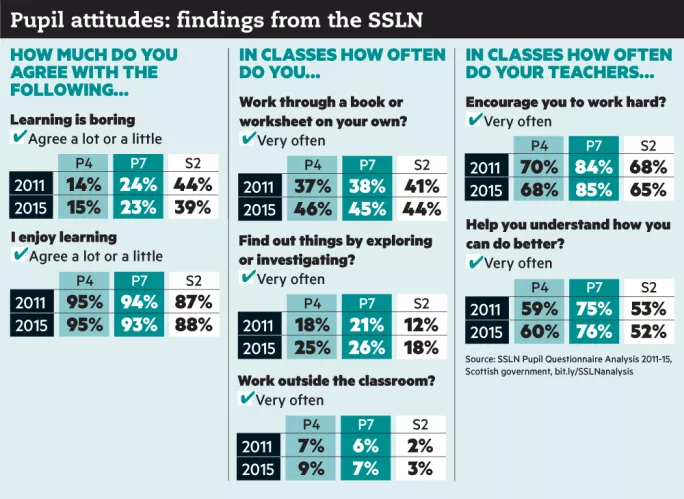Pupils complain of ‘boring’ schoolwork - despite CfE

Curriculum for Excellence is failing to engage large numbers of pupils, and by secondary school well over a third think that “learning is boring”, new figures reveal.
The Scottish government report finds that many continue to be uninspired, despite the curriculum ushering in greater flexibility for pupils to explore what interests them.
The study notes that an increasing proportion of Scottish pupils are frequently finding things out by investigating and solving problems independently. However, in the past five years, there has been no significant change in the proportion who agree with the statement “learning is boring”.
In 2015, this figure was 15 per cent for P4s and 23 per cent for P7s. At S2, while there was a small improvement in attitudes, 39 per cent of pupils still reported finding lessons tedious (in 2011, 44 per cent agreed that learning was boring).
An increasing proportion of pupils at all levels also said they were “very often” asked to work through books or worksheets on their own.
Personalised approach
The figures will come as a blow to the Scottish government, given that one of the central aims of the new curriculum was to increase pupil engagement by freeing teachers to adapt their teaching to individual circumstances.
The data was collected as part of the Scottish Survey of Literacy and Numeracy (SSLN), which will be scrapped next year.
The survey also highlights the gulf between how supported pupils feel by their teachers in primary and secondary. Between 2011 and 2015 the proportion of S2 pupils reporting they were “very often” encouraged to work hard fell from 68 per cent to 65 per cent. The proportion that said their teachers “very often” explained how their learning was relevant fell from 26 to 22 per cent.
Iain Gray, education spokesman for Scottish Labour, described the findings as “worrying” and said this was the price of government cuts to education.
He called on the SNP to “stop messing around” with the school governance consultation and to concentrate on ensuring schools were properly staffed.
Mr Gray said: “We have a highly trained and professional teaching workforce, but in recent years they have been put under more and more pressure. There are almost 4,500 fewer, for a start, and class sizes have grown.
“Meanwhile, all kinds of support for teachers - from classroom assistants to additional support workers and lab technicians - have disappeared from our schools. All the while, teachers have had to implement a new curriculum and new exams with little resource.
“These numbers suggest that a price has been paid for these cuts in damage to the school experience, especially in secondary.”

Majority of pupils ‘happy’
However, Larry Flanagan, general secretary of the EIS teaching union, argued that the majority of pupils were happy at school. Secondary teachers may have come off worse in the survey because S2 pupils needed to dislike only one of their teachers for them to feel less positive overall, he said.
Mr Flanagan added: “It’s useful to look at these kinds of surveys but the vast majority of secondary pupils are happy with their experience, which, given they are hormonal teenagers, is something we can be proud of.”
The figures were published quietly by the Scottish government several months after the main SSLN report went public.
The survey into pupil attitudes covers a wide range of questions - from how often pupils use computers in class to how often they get help with homework.
There were also some positive trends: pupils across primary and secondary reported exploring and investigating more in lessons, and engaging in more problem-solving.
The vast majority of pupils also have a positive view of school - in 2015, 95 per cent of P4 children agreed with the statement “I enjoy learning”. This figure was 93 per cent of P7 children and 88 per cent for S2 pupils.
A Scottish government spokesperson said that CfE provided “a flexible model for teachers to design learning, which meets the needs of individual pupils, adapting to their individual styles, backgrounds and preferences.”
They stressed that engagement with learning, motivation and perception of usefulness of learning were high at all levels.

You need a Tes subscription to read this article
Subscribe now to read this article and get other subscriber-only content:
- Unlimited access to all Tes magazine content
- Exclusive subscriber-only stories
- Award-winning email newsletters
Already a subscriber? Log in
You need a subscription to read this article
Subscribe now to read this article and get other subscriber-only content, including:
- Unlimited access to all Tes magazine content
- Exclusive subscriber-only stories
- Award-winning email newsletters